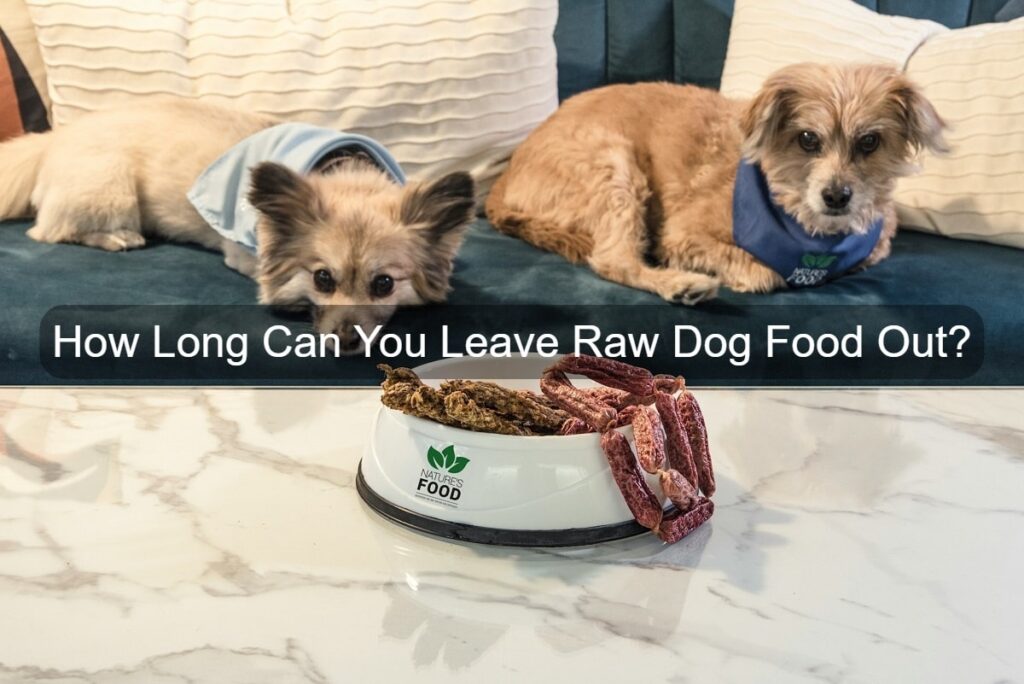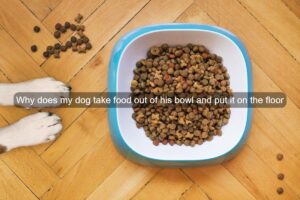Do you know how long you can leave raw dog food out before it becomes a health hazard? Leaving it out too long can lead to harmful bacteria growth, putting your furry friend at risk of sickness.
How could you see your pet suffering from a preventable illness caused by mishandled food? It’s not just about their health – about your peace of mind and your bond with your loyal companion.
But don’t fret out. In this article, we’ll break down the ins and outs of storing raw dog food safely, ensuring your pet stays healthy and happy, and guide you about how long raw dog food can be left out.
How long can thawed raw dog food be left out of the fridge?
As raw dog food comes in patties or balls containing raw meat, organs, veggies, and bones that perish soon, you need to store it properly as you store it for human use. But, the duration of keeping it safe depends on the weather. If the weather is too hot, it is suggested to keep leftover food from a dog’s bowl for 15-30 minutes, or if the weather is cool, keep the leftover food for 1-2 hours.
The raw dog food is frozen, or for security, you have to save it in the freezer, but to feed it to dogs, you have to put it off from the freezer, and it might take 12-24 hours to defrost. After it defrosts, take a small portion needed for serving and keep that defrosted food in the fridge for 3 days. As your dog never completed the served food, keep it again in the fridge within 10-15 minutes and serve it for the second time meal, but if he never finishes it again, throw it away and never push your dog to eat that food again because now there is an excellent danger of bacterial growth on that food.
What are the risks of feeding dogs leftover food after a long time?
Raw dog food is the best option for dogs because they are carnivores and love the treat of eating something raw. However, despite its nutritional benefits, raw dog food can pose significant risks if not handled and stored correctly. When left out at room temperature, raw dog food becomes a breeding ground for harmful bacteria, including Salmonella, Escherichia coli (E. coli), and Listeria monocytogenes (Listeria). These bacteria are commonly found in raw meat and can cause severe illnesses in dogs and humans if ingested:
- Salmonella is a bacterium known to cause salmonellosis, a food-borne illness characterized by vomiting, diarrhoea, fever, abdominal cramps, lethargy, and decreased appetite. In severe cases, Salmonella infection can lead to dehydration and even death, particularly in puppies, elderly dogs, or those with weakened immune systems.
- coli is another bacterial species commonly associated with raw meat and can cause infections in dogs and humans. Ingestion of E. coli-contaminated raw dog food can lead to symptoms such as diarrhea, abdominal pain, and in severe cases, kidney failure.
- Listeria monocytogenes is another dangerous bacterium found in raw meat, capable of causing listeriosis, a severe infection with symptoms ranging from flu-like symptoms to meningitis, septicemia, and miscarriage in pregnant dogs. Dogs may display symptoms such as fever, muscle stiffness, and difficulty breathing if infected with Listeria.
What are the factors affecting the spoilage of raw dog food?

Raw dog food perishes soon, so you must be aware of 110% of the freezing, defrosting, and refreezing raw dog food strategies to keep them safe and secure for your dogs.
Temperature:
Temperature plays a significant role in the bacterial growth rate in raw dog food. Ideally, raw dog food should be stored below 40°F (4°C) to inhibit bacterial proliferation. Bacteria can multiply rapidly at higher temperatures, increasing the risk of food-borne illnesses.
Humidity:
Humidity levels also impact the preservation of raw dog food. High humidity can accelerate spoilage by creating an environment conducive to bacterial growth. To mitigate this risk, store raw dog food in a cool, dry place and avoid exposure to moisture.
Air Exposure:
Air exposure can expedite the spoilage of raw dog food. Oxygen promotes the growth of aerobic bacteria, leading to decomposition.
Food Composition:
The composition of raw dog food, including the types of meat and organs used, can influence its susceptibility to spoilage. For example, lean meats may spoil more slowly than fatty cuts due to differences in water content and microbial activity. Similarly, organs such as the liver and kidney may spoil more rapidly than muscle meat due to their higher moisture content and nutrient density.
The pH level of raw dog food can impact its susceptibility to bacterial growth and spoilage. Foods with a higher pH (more alkaline) are generally more resistant to spoilage, while those with a lower pH (more acidic) may spoil more rapidly. Raw dog food that includes acidic ingredients such as fruits or vegetables may have a lower pH and, thus, a reduced risk of spoilage.
Contamination:
Contamination from external sources, such as cross-contact with other raw foods or exposure to unclean surfaces, can introduce harmful bacteria and accelerate spoilage.
Packaging:
The type of packaging used to store raw dog food can affect its shelf life and susceptibility to spoilage. Air-tight, moisture-resistant containers or vacuum-sealed bags can help preserve the freshness of raw dog food by minimizing exposure to oxygen and moisture. Transparent packaging should be avoided as it allows light to penetrate, degrading nutrients and promoting bacterial growth.
Storage Duration:
The length of time raw dog food is stored before and after feeding can impact its safety and quality. In contrast, refrigeration or freezing can slow bacterial growth and extend shelf life; raw dog food should not be stored indefinitely. It’s essential to adhere to recommended storage guidelines and use raw dog food within a reasonable time frame to minimize the risk of spoilage and ensure nutritional integrity.
What signs show that raw dog food is spoiled if left out for more than the suggested time?
Raw dog food should be included in the fridge for three days after keeping out of the freezer, but what signs show me that my dog’s food should never be used?
Smell Test
A foul or unusual odor emanating from raw dog food clearly indicates spoilage. Trust your sense of smell and discard any raw dog food that emits a rancid or unpleasant odor. Spoiled food can pose health risks to pets and should not be consumed.
Texture Changes
In addition to visual cues, changes in the texture of raw dog food can indicate spoilage. Fresh raw dog food should have a firm, moist texture. If the food feels excessively mushy, slimy, or gritty, it may be spoiled and should be discarded.
Abnormal Growth
In some cases, spoiled raw dog food may exhibit abnormal growth, such as mold or fungal growth. Mold can appear as fuzzy patches or spots on the surface of the food and is a clear indication of contamination and spoilage. Any signs of mold growth should prompt immediate disposal of the affected food.
Presence of Foreign Objects
Inspect raw dog food for foreign objects or contaminants that may have inadvertently entered the food during preparation or storage. Foreign objects such as hair, insects, or debris can compromise the safety and quality of the food and should be considered signs of spoilage.
Changes in Taste
While dogs may not always display discerning taste preferences, changes in the taste or flavor of raw dog food can indicate spoilage. If your dog suddenly refuses to eat or shows reluctance to consume their usual food, it may be a sign that the food has gone wrong. Trust your pet’s instincts and monitor their behavior for any indications of discomfort or illness.
Expiration Date
Check the expiration date or “use by” date on the packaging of raw dog food products. Consuming expired food can pose health risks to pets and should be avoided.
How long can I leave raw dog food out if it’s frozen?
If raw dog food has been frozen, it can be safely left out for a short period while it thaws in the refrigerator. However, once thawed, raw dog food should not be left out at room temperature for more than two hours, and if you serve it to dogie, he should finish it within 15 minutes; otherwise, quickly transfer it to the fridge or if you are sure that he will never eat it again, throw it to prevent bacterial growth and ensure safety.
FAQ’s
In what condition is raw dog food not suitable for my dog?
There are multiple benefits of raw dog food for optimal health as it is a suitable diet for many dogs because of their wild nature, but the alternatives to raw dog food are available if your dog is facing these problems and cannot take raw dog food more.
- Allergies with grain and fillers
- Irritable bowel syndrome (IBS) or Inflammatory bowel disease (IBD).
- Over-weighted dogs
- Diabetes, cancer, or renal disease.
- Dogs with dental issues.
- Puppies less than 12 weeks.
- Immune-compromised dogs (under therapies)
Can I leave raw dog food out overnight?
It is not recommended to leave raw dog food out overnight; this time, it should always be, at most, 15 minutes after serving. Overnight exposure allows ample time for bacteria to multiply, increasing the risk of spoilage and contamination.
Can you feed raw food to dogs directly from the fridge?
While it’s possible to feed raw food to dogs directly from the fridge, it’s generally not recommended for several reasons, such as cold food being uncomfortable for your dog’s digestion. Letting it sit at room temperature for 5-10 minutes allows it to warm slightly, making it more palatable and accessible to absorb. Moreover, Some nutrients become less bio-available when cold, meaning your dog might need to absorb them more efficiently. Bringing the food closer to room temperature helps optimize nutrient uptake.
Final Thoughts on Leaving Raw Dog Food Out?
Raw dog food has multiple benefits for the dogs. Still, at the same time, it is a way to get your dog to be introduced to bacteria, so whenever you get the food from the freezer, the food’s room temperature should not exceed 2 hours, and the leftover food should be more than 15 minutes.





